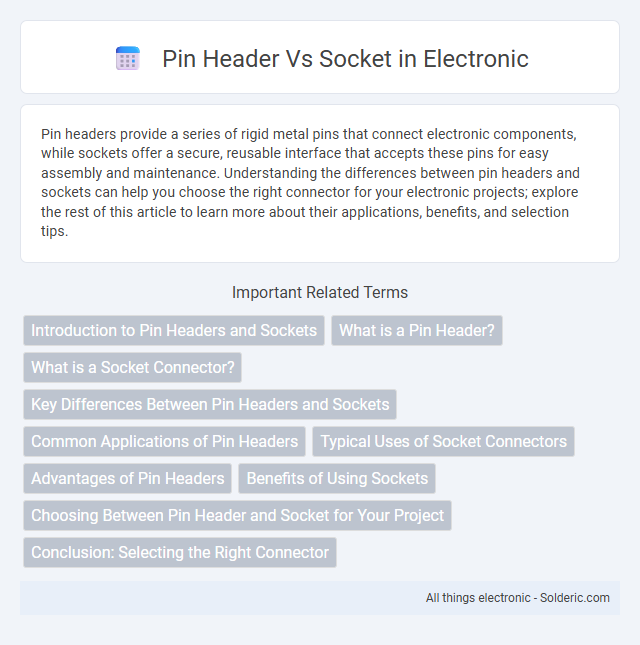Pin headers provide a series of rigid metal pins that connect electronic components, while sockets offer a secure, reusable interface that accepts these pins for easy assembly and maintenance. Understanding the differences between pin headers and sockets can help you choose the right connector for your electronic projects; explore the rest of this article to learn more about their applications, benefits, and selection tips.
Comparison Table
| Feature | Pin Header | Socket |
|---|---|---|
| Definition | Male connector with exposed pins | Female connector with receptacles |
| Function | Provides connection points for mating connectors | Accepts pins to establish electrical contact |
| Use Case | Common on PCBs for modular connections | Used to receive pin headers or other male contacts |
| Material | Usually metal pins with plastic base | Metal contact sockets within plastic housing |
| Installation | Soldered or press-fit onto circuit boards | Soldered onto PCB or as standalone connectors |
| Durability | Prone to bending if not handled properly | Typically more durable due to enclosed contacts |
| Contact Reliability | Direct pin contact; can wear over time | Provides secure grip on pins for stable connection |
| Typical Applications | Development boards, microcontroller connections | Inter-board connections, removable wiring |
Introduction to Pin Headers and Sockets
Pin headers consist of a row or grid of metal pins used as connectors on printed circuit boards (PCBs) to interface with other components. Sockets serve as receptacles that securely receive pin headers, enabling easy connections and disconnections without soldering. Together, pin headers and sockets facilitate modular and reliable electronic assemblies by providing standardized electrical connections.
What is a Pin Header?
A pin header is a type of electrical connector consisting of multiple metal pins arranged in a row or grid, typically mounted on a printed circuit board (PCB). It serves as a male connector that can be easily inserted into complementary sockets or connectors, enabling secure and removable electrical connections for your electronic projects or devices. Pin headers are widely used in applications requiring modular connections, such as prototyping, embedded systems, and various consumer electronics.
What is a Socket Connector?
A socket connector is an electrical component designed to receive and securely hold a pin header, facilitating reliable connections between circuit boards or electronic devices. It provides a precise fit with metal contacts inside the socket that align with the pin header's pins, ensuring stable electrical contact and easy insertion or removal. Your choice of socket connector impacts connection durability and signal integrity in electronic assemblies.
Key Differences Between Pin Headers and Sockets
Pin headers are male connectors featuring multiple exposed metal pins designed to be inserted into corresponding female sockets, which contain recessed contacts providing a secure electrical connection. Sockets serve as female connectors that ensure stability and ease of replacement, while pin headers act as the male counterpart, often soldered onto printed circuit boards (PCBs). Understanding The key differences between pin headers and sockets helps you select the appropriate component for your electronic project, balancing durability, ease of assembly, and signal integrity.
Common Applications of Pin Headers
Pin headers are widely used in electronics for connecting components on printed circuit boards (PCBs), especially in prototyping and development of microcontroller projects like Arduino and Raspberry Pi. Their compatibility with sockets allows easy insertion and removal, making them ideal for modular designs, signal transmission, and power connections in automation, robotics, and industrial equipment. Your choice of pin headers can influence assembly efficiency and durability in applications such as LED displays, sensors, and communication devices.
Typical Uses of Socket Connectors
Socket connectors are commonly used in electronic devices to provide removable connections for components such as printed circuit boards, sensors, and modules. They facilitate easy assembly, maintenance, and replacement without soldering, making them ideal for prototype development and modular systems. Frequently found in computing hardware, automotive electronics, and telecommunications equipment, socket connectors enhance flexibility and reliability in electrical connections.
Advantages of Pin Headers
Pin headers offer robust mechanical stability and reliable electrical connections, making them ideal for high-vibration environments. Their straightforward design enables easy soldering and efficient mass production in electronics manufacturing. Pin headers also provide versatile compatibility with various socket types, streamlining prototyping and modular system assembly.
Benefits of Using Sockets
Sockets offer improved flexibility and ease of maintenance by allowing components to be easily inserted or removed without soldering. They provide enhanced durability by reducing wear and tear on circuit boards during frequent connections and disconnections. Using sockets protects your devices from damage and simplifies upgrades or repairs in complex electronic systems.
Choosing Between Pin Header and Socket for Your Project
Choosing between a pin header and a socket depends on your project's requirements for ease of connection and durability. Pin headers provide a straightforward, soldered connection ideal for permanent setups, while sockets offer flexibility with removable components, facilitating troubleshooting and upgrades. Consider the operating environment, mechanical stress, and frequency of disconnection when selecting the appropriate connector to ensure optimal electrical performance and longevity.
Conclusion: Selecting the Right Connector
Choosing between a pin header and socket depends on your project's specific needs for durability, ease of connection, and signal integrity. Pin headers offer reliable soldered connections ideal for permanent setups, while sockets provide flexibility for frequent component replacements or testing. Ensure Your selection aligns with the required mechanical stability and electrical performance to optimize functionality and maintenance.
Pin header vs socket Infographic

 solderic.com
solderic.com